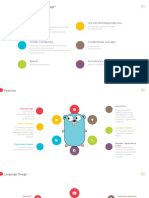0% found this document useful (0 votes)
228 views1 pageGolang
Go is a statically typed, compiled programming language designed by Google engineers. It aims for simplicity, efficiency, and concurrency support through features like goroutines and channels. Go has a minimal syntax, built-in types, a fast compiler, garbage collection, and a standard library for common tasks.
Uploaded by
soubhagya pandaCopyright
© © All Rights Reserved
We take content rights seriously. If you suspect this is your content, claim it here.
Available Formats
Download as TXT, PDF, TXT or read online on Scribd
0% found this document useful (0 votes)
228 views1 pageGolang
Go is a statically typed, compiled programming language designed by Google engineers. It aims for simplicity, efficiency, and concurrency support through features like goroutines and channels. Go has a minimal syntax, built-in types, a fast compiler, garbage collection, and a standard library for common tasks.
Uploaded by
soubhagya pandaCopyright
© © All Rights Reserved
We take content rights seriously. If you suspect this is your content, claim it here.
Available Formats
Download as TXT, PDF, TXT or read online on Scribd
/ 1























































